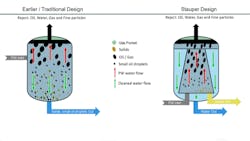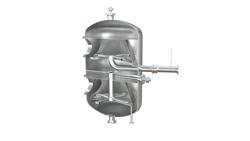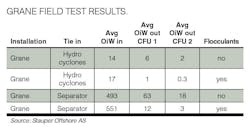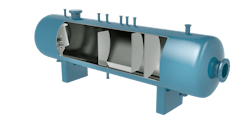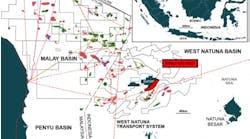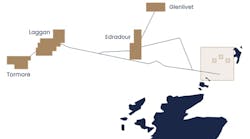Roland Ofstad and Rune G. Nilssen, Stauper Offshore AS
Produced water is becoming more of an issue for oil producers, both in terms of increased water cuts in mature fields and the more stringent environmental requirements being implemented. It is estimated that 250 Bbbl of water are “produced” every day worldwide, and this water must be cleaned down to microscopic levels before being discharged or reinjected into the reservoir to maintain pressure. The last step in produced water treatment is often to use a compact flotation unit (CFU) to ensure the oil-in-water (OiW) level is reduced to national requirements, less than 30 ppm or often far below.
The first CFU was developed and patented in Norway 20 years ago in order to accommodate space and weight constraints at offshore production platforms. Today, the CFU is a well-established flotation technology in use all over the world. Joern Folkvang, one of the founders of Stauper Offshore was also the co-inventor of the first CFU in 1999. He has since authored several patents for CFU related technologies, most recently the patented Stauper CFU.
Earlier design principles
CFU is a vertical separation vessel that uses gas flotation principle. In other words, the main vehicle for separation of the oil from water is gas, either dissolved in or added to the produced water. Gas aids in the agglomeration and coalesce of the oil droplets. The expanding bubbles will rise the oil to the top of the vessel where it is removed.
In the earlier generations of CFU technology, this process happens in an open vessel where water is often introduced at the upper part of the vessel, and coalescence, flotation, and separation are all done in the open setting. These earlier designs carry many challenges, including counter-current flow, where smaller oil droplets and solids tend to follow the gravity and stream of treated water, thereby impeding efficiency.
Further on, the energy in the open vessel, with continuous moving water is less than ideal for removing oil from water.
Main features of the Stauper CFU
Stauper has solved the challenges in earlier designs by developing a new set of internals: a separate inlet chamber with a unique water flow and control. Water is introduced at the bottom of the vessel, into the inlet chamber where several non-moving tangentially distribution pipes create a stronger coalescence and oil droplet expansion. The inlet chamber traps small oil droplets forcing them up rather than out with the water. Solids are captured and flushed out at the bottom.
The patented Stauper CFU also has unique features that make the water flow come to a complete stand-still at the top of the tank, which again makes for an easy reject of oil and gas. At the bottom there is also reject of solids, which can be operated automatically or manually. This helps against clogging and reduces the need for maintenance. The clean water flows down on the outside of the inner chamber and is then discharged.
For many oil producers operating in cramped facilities, space limitations might call for designs that have two or more cleaning stages in one CFU vessel. Therefore, the company has also developed a design that will reduce both footprint and weight.
Retrofit
The fundamental idea behind the Stauper CFU is the water flow control by the inlet chamber. This inlet chamber can also easily be installed and retrofitted into existing oil and water separation vessels. For instance, degassers, open-vessel design CFUs, and water oil separators. The economic and environmental benefits are significant compared to investing in new process equipment. Earlier this year, a major operator awarded the company a contract to retrofit two, existing open-vessel design CFUs. Another operator has commissioned the company to determine if its challenged open design CFUs can be retrofitted.
Stauper has a patent pending methodology for introducing and installing the patented inlet chamber through the manway without welding. Adding gas at the inlet, the chamber will coalesce oil and gas, and create bigger oil droplets that are easier to extract using the separation vessel’s existing components.
The benefits of retrofitting are:
• Low capex – installation in existing process equipment
• The company’s separation chamber removes solids from water. Reduce downstream wear and tear and maintenance
• Better oil separation and reject – lower oil in water discharge
• Better separation in degasser – reduced retention time and footprint (reduction of capex)
• Can be installed in existing and new degassers. (New degasser can be reduced in size due to less retention time).
Technology testing
The Stauper CFU began rigorous testing at the Equinor Research Centre in Norway in June 2016, and the results were highly encouraging. Equinor also wanted an offshore field test, and this was performed at the Grane field in the North Sea in June 2017. The tests were documented by a third party, COWI. The test was performed with two CFUs (each with 6 cu m/hr flow rate) in series and at three separate tie-in points, and with variations in: turndown (%), gas/water ratio (GWR), operating pressure, reject rate, and with or without the use of flocculants. The conclusion was that the CFU was not only very efficient in removal of OiW, but also that its performance was not affected by even big variations in turndown, GWR, or operating pressure.
In addition to highly efficient cleaning and OiW levels reduced to 0.3 ppm (98.2% reduction) under certain operating parameters, the test also showed that a multi-stage Stauper CFU in many instances can be tied in downstream from de-oilers and replace both hydrocyclones and degassers. This will have the potential to reduce footprint, weight, cost, and maintenance on offshore installations.
The company has subsequently been granted technology qualification allowing for first use at Equinor installations.
Commercial deliveries
Based on subsequent offshore tests in China, where OiW was reduced by up to 95%, the company received its first commercial orders from CNOOC for CFU deliveries on offshore platforms and FPSOs in the South China Sea. All CFU deliveries to CNOOC are engineered by Stauper and manufactured by BOMESC Offshore Engineering Co. Ltd. To date there are five completed installations and a sixth is expected online by the end of the first half of this year. The most recent installation came online at the Caofeidian oil field development. Here the unit is handling 1,650 cu m/hr (247,000 b/d of water). The one-stage CFU is removing 90% oil without using chemicals.
Unmanned production platforms
Over the last 12 months the company has worked with a leading operator in order to get qualification to supply CFU technology for unmanned production platforms. These installations are developed to have cost and environmental benefits similar to subsea installations. In order to be qualified for unmanned installations, the company must pass extensive testing and scrutiny around efficiency, robustness, and stability. Stauper expects the qualification to be awarded later this year. •

